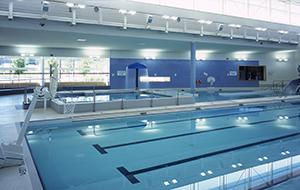Swimmers, bathers and spectators at indoor public swimming pools may experience difficulty breathing or other health-related problems due to a buildup of chloramines in indoor air. Since chlorine is the most widely used disinfectant, some level of chloramines is expected in indoor air at public swimming pools and spas. Maintaining proper water chemistry and showering before using the pool or spa will greatly reduce the amount of chloramines in indoor air at these settings.
What are chloramines?
Chloramines are disinfection byproducts that are formed from the reaction of chlorine with nitrogen products, including sweat, urine, dirt and other wastes generated from swimmers using the indoor pool or spa. Chloramines appear as combined chlorine in routine water quality tests. Chloramines are best identified by their distinct chlorine odor in indoor pools and spas.
Is there an enforceable standard for chloramines at public pools or spas?
There is no standard that regulates the amount of chloramines in indoor air at public swimming pools or spas. A water quality standard of less than 0.2 parts per million (ppm) is required for the combined chlorine level in public swimming pools and spas. A field water quality test is used to measure the amount of combined chlorine each hour the pool or spa is operational. This test provides management staff with key information as to when a pool or spa must be super-chlorinated or shocked. Super-chlorination rids the pool or spa of the buildup of the disinfection byproduct, chloramines.
How do chloramines enter the air at indoor public swimming pool settings?
Chloramines can move readily into indoor air from pool or spa water as chloramine levels increase or as the bather load increases. Warm water temperatures or the amount of agitation from fountains, sprays or slides also increases the amount of chloramines that can affect indoor air at indoor pool and spa settings. Air recycling devices may concentrate chloramines as these devices recycle air to save on heating costs and provide less makeup air into a facility.
What type of symptoms might I experience from exposure to chloramines in indoor air at public swimming pools?
The U.S. Centers for Disease Control and Prevention (CDC) indicates that exposure may include symptoms such as difficulty breathing, coughing, stinging or red eyes, wheezing, aggravating asthma or increased sensitivity to other types of irritants in the environment.
As a bather, what measures can I take to reduce chloramines at indoor public swimming pools?
Showering. Showering before using or entering the swimming pool or spa is always recommended and is the easiest way to reduce chloramines in pool or spa water. By showering, you reduce the amount of sweat, dirt, debris and other waste entering the pool or spa and the demand on chlorine as a disinfectant.
Toilet Use. Frequent bathroom breaks are recommended to ensure swimmers, bathers, and other pool and spa users do not urinate in the swimming pool or spa.
What voluntary measures could a facility take to reduce chloramines in indoor air at indoor public swimming pools?
Secondary Disinfectants. A facility may consider the addition of a secondary disinfectant such as ultraviolet light or ozone. The secondary disinfectant will reduce the demand on free available chlorine as a disinfectant in pool water and, coupled with proper pool management, will reduce the amount of chloramines in indoor air.
Ventilation Enhancements. The Model Aquatic Health Code, Ventilation Module provides new recommendations from the CDC to address chloramines in indoor air at public pools and spas. The ventilation enhancements generally require that additional makeup air be provided when the indoor pool or spa is in operation or is occupied with swimmers, bathers or spectators.
What constitutes a violation?
A violation exists when the combined chlorine or chloramines exceed 0.2 parts per million in the pool or spa water. The operator of the public swimming pool will be required to super-chlorinate or shock the public swimming pool to reduce the combined chlorine to an acceptable level.
How do I file a complaint?
Residents may file a complaint by contacting the Department of Health at the number listed below. The complaint will be investigated within 10 business days. The public may receive updates on inspection results and enforcement actions.
Where can I obtain more information?
Sanitary Engineering Program
Anne Arundel County Department of Health
3 Harry S. Truman Parkway
Annapolis, Maryland 21401
410-222-7217

